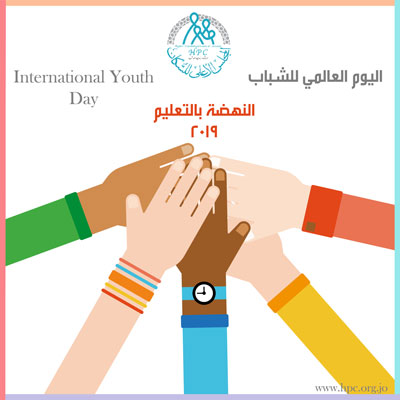

August 12th of each year marks International Population Day which was designated by the United Nations General Assembly on December 17th, 1999 as an annual celebration of the role of young women and men as key partners in change. This day presents an opportunity to raise awareness on the challenges facing this group all around the world. This year’s celebration is under the theme “transforming education” in order to highlight efforts, including efforts of youth themselves, to make education inclusive of everyone and more accessible to youth and emphasize the importance of Goal 4 of the 2030 Agenda for Sustainable Development – to “ensure inclusive and equitable quality education and promote lifelong learning opportunities for all”.
Inclusive and accessible education is crucial to achieving sustainable development. Education is a ‘development multiplier’ in that it plays a pivotal role in accelerating progress across all 17 Sustainable Development Goals, be it poverty eradication, good health, gender equality, decent work and growth, reduced inequalities, action on climate or building peaceful societies. Education should lead to effective learning outcomes, with the content of school curricula and pedagogy being fit for purpose, not only for the 4th industrial revolution and the future of work and life, but also for the opportunities and challenges that rapidly changing social contexts bring.
International Youth Day 2019 will examine how governments, young people and youth-led and youth-focused organizations are transforming education and how these efforts are contributing to the achievement of the 2030 Agenda for Sustainable Development.
In Jordan, investment in education is one of the main national priorities as part of relying on human capabilities and their competitiveness in achieving prosperity. Despite its poor national resources, Jordan has achieved tangible steps in human resources development and transformation of education on different level as well as in providing a clear framework for all education-related sectors. These steps include:
- Development of the national strategy for human resources development titled “Education for Prosperity: Delivering Results – A National Strategy for Human Resource Development 2016-2025” which lays the basis for the future of education in Jordan and provides a framework for all sectors concerned with education and develops primary and higher education as well as vocational and technical training and which generally aims to usher in a qualitative leap for national human resource development and identify reform policies that support modernization and progress.
- The 7th Discussion Paper by His Majesty King Abdullah II: “Developing Human Resources and Education Imperative for Jordan’s Progress” in which His Majesty presented his vision for the education sector reform.
Jordan’s great interest in the education sector was reflected through the achievements in this regard. Indicators of such achievements include:
- According to the Department of Statistics’ Jordan in Figures 2018 publication, the illiteracy rate among Jordanians aged 15 and more dropped to (5.1%) with the rate being 3.1% among males and 7.2% among females. The percentage of persons with a scientific degree beyond high school rose to 26.5% with the rate being 24.9% among males and 28.1 among females.
- Achievement of almost inclusive education for Jordanians, except for KG2 which is one of the Government’s priorities for the next five years.
According to the MoE’s Strategic Plan (2018-2022), the gross enrolment rate in KG2 among Jordanians (2015/2016) was 79.5% (80.6% among males and 78.3% among females). The enrolment rate in the basic level was 123.9% (124% among males and 123.9 among females) and enrolment rate in the secondary level was 98% (91.3% among males and 105.5% among females).
- According to MoHE’s statistics, the number of Jordanian universities graduates rose to (68998 students) in 2016/2017. The number of graduates of vocational diploma, intermediate diploma, bachelor’s degree, master’s degree and postgraduate diploma and higher was (83), (1832), (61342), (2432) and (1164), respectively.
Despite the many achievements in the field of youth education, many obstacles continue to face Jordan’s progress in transforming education, most notably:
- Education outputs are still facing many challenges as graduates’ skills do not meet the requirements and needs of Jordan’s economy and the labor market.
- Each year, more than half the school students fail Tawjihi exams and leave school without having clear alternative opportunities.
- Negative perceptions of education and vocational and technical training among students and their families.
- Growing numbers of university graduates met by a lack of skilled craftsmen and technicians and high unemployment rates among them. Jordanians holding a BA degree or more comprised 23.5% of the population in 2018, peaking at 31.1% among females in the same year.
- Higher youth unemployment rates reaching 39.2% with a poor economic participation rate of 24.7% in 2018, one of the lowest worldwide.
Considering young people in the Jordanian society aged (15-24 years) comprise 20% of the overall population, i.e. more than two million young man and woman, according to the Department of Statistics’ estimates for 2018 and since such rate is subject to increase in light of the demographic transition Jordan is going through, utilizing change in the population’s age structure and transforming such change to a real opportunity for development requires:
- Adapting the education policies to respond to the changing needs of the labor market and world economy.
- Promoting entrepreneurship, creativity and technology skills among young people, strengthening their competitiveness in labor markets.
- Encourage investments in raising the quality of education in order to properly build such skills in youth for them to adapt to the changing needs of working forces.







